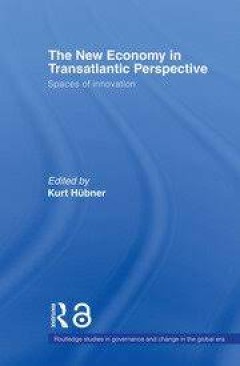Filter by

Institutional frameworks and labor market performance: comparative views on t…
Institutional Frameworks and Labor Market Performance produces an in-depth analysis of the functioning of various labor market institutions in both the USA and Germany. Particular emphasis is given to the substantial differences between the US and Germany in the ways important areas are regulated. The authors show that the impact of institutions on economic performance is ambivalent. They argue…
- Edition
- 1st Edition
- ISBN/ISSN
- -
- Collation
- -
- Series Title
- -
- Call Number
- -

Budgetary policy modelling: public expenditures
The focus of this volume is on the European context of public budget policy and a variety of different approaches are used - theoretical modelling, econometrics and applied general equilibrium modelling. Empirical evidence and case studies of European countries are contained in all the papers. The papers cover the four general themes of public budget policy: * economic stabilization, in view …
- Edition
- -
- ISBN/ISSN
- 9780203979372
- Collation
- -
- Series Title
- -
- Call Number
- -

Urbanizing the Regional Sector to Strengthen Economy and Business to Recover …
This pandemic does not only affect health aspects but also economic aspects. The world today faces a recession resulting from the covid-19 pandemic. Indonesia's economy continues to lead to a recovery, although not very significant. The current government continues to make various recovery efforts. One of the flagship programs includes encouraging and strengthening support for social protection…
- Edition
- -
- ISBN/ISSN
- 9781003303336
- Collation
- -
- Series Title
- -
- Call Number
- -

Building Communities of Trust Creative Work for Social Change
Drawing upon a combination of ethnographic research and media and communication theory, Building Communities of Trust: Creative Work for Social Change offers pathways to building trust in a range of situations and communities. Ann Feldman presents rich examples from her own life and social-impact journey with nonprofit, Artistic Circles, along with supplemental case studies from interviews w…
- Edition
- -
- ISBN/ISSN
- 9781003296423
- Collation
- -
- Series Title
- -
- Call Number
- -

Sustainable Food Futures: Multidisciplinary Solutions
Securing sustainable food for everyone is one of the world's most pressing challenges, but research, policy, and programmes remain fragmented, and effective solutions have been slow to emerge. This book takes on these challenges by proposing a range of solutions that can advance pathways towards sustainable food futures. Complete with recipes, this book is structured so that readers are taken …
- Edition
- -
- ISBN/ISSN
- -
- Collation
- -
- Series Title
- -
- Call Number
- -

EU Cohesion Policy: Reassessing performance and direction
This book brings together academics, members of European institutions, and regional and national level policymakers in order to assess the performance and direction of EU Cohesion policy against the background of the most significant reforms to the policy in a generation. Responding to past criticisms of the effectiveness of the policy, the policy changes introduced in 2013 have aligned Europea…
- Edition
- -
- ISBN/ISSN
- 9781315401867
- Collation
- -
- Series Title
- -
- Call Number
- -

Imperial Technology and 'Native' Agency: A Social History of Railways in Colo…
This book explores the impact of railways on colonial Indian society from the commencement of railway operations in the mid-nineteenth to the early decades of the twentieth century. The book represents a historiographical departure. Using new archival evidence as well as travelogues written by Indian railway travellers in Bengali and Hindi, this book suggests that the impact of railways on col…
- Edition
- -
- ISBN/ISSN
- 9781315397108
- Collation
- -
- Series Title
- -
- Call Number
- -

Power politics, Banking Union and EMU: adjusting Europe to Germany
This book examines the politics of Banking Union and EMU reform in the EU, and draws lessons for what it means for international politics, both in Europe, and for international relations more broadly. It demonstrates that most of the reforms in Europe to break free of the Eurozone and banking crises in which Europe continues to find itself focus on building up the capacities of national authori…
- Edition
- -
- ISBN/ISSN
- 9780203702130
- Collation
- -
- Series Title
- -
- Call Number
- -

Entrepreneurship: A New Perspective
The entrepreneur has been neglected over the years in formal economic theorizing. Previously there has been only eclectic theories such as human capital theory and network dynamics which discuss certain perspectives of entrepreneurial behaviour. This insightful book closes this gap in entrepreneurship literature. Inspired by modern physics, author Thomas Grebel brings together an evolutionary …
- Edition
- 1st Edition
- ISBN/ISSN
- 9780203478745
- Collation
- -
- Series Title
- -
- Call Number
- -

The New Economy in Transatlantic Perspective
ABSTRACT What’s left from the new economy? This book takes an unfashionable perspective and shows that despite all the mistaken ideas and exaggerations, the technological changes of the 1990s still have important effects today. Economic history shows that technological revolutions tend to generate deep economic and social crises before a temporary state of equilibrium is reached. The esta…
- Edition
- 1st Edition
- ISBN/ISSN
- 9780203420966
- Collation
- -
- Series Title
- -
- Call Number
- -
 Computer Science, Information & General Works
Computer Science, Information & General Works  Philosophy & Psychology
Philosophy & Psychology  Religion
Religion  Social Sciences
Social Sciences  Language
Language  Pure Science
Pure Science  Applied Sciences
Applied Sciences  Art & Recreation
Art & Recreation  Literature
Literature  History & Geography
History & Geography